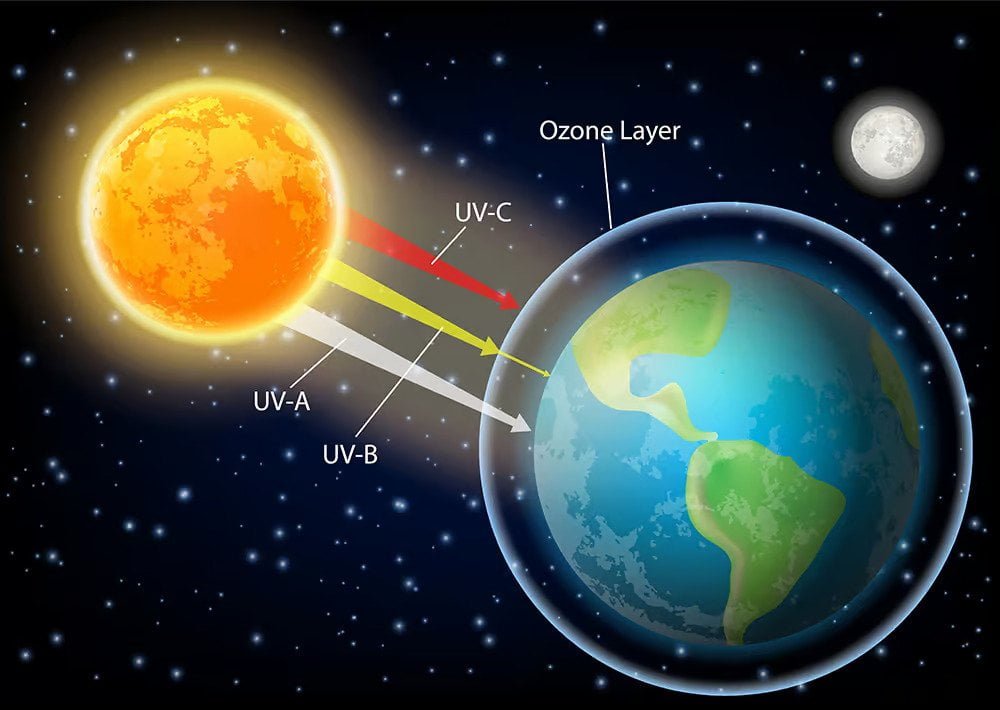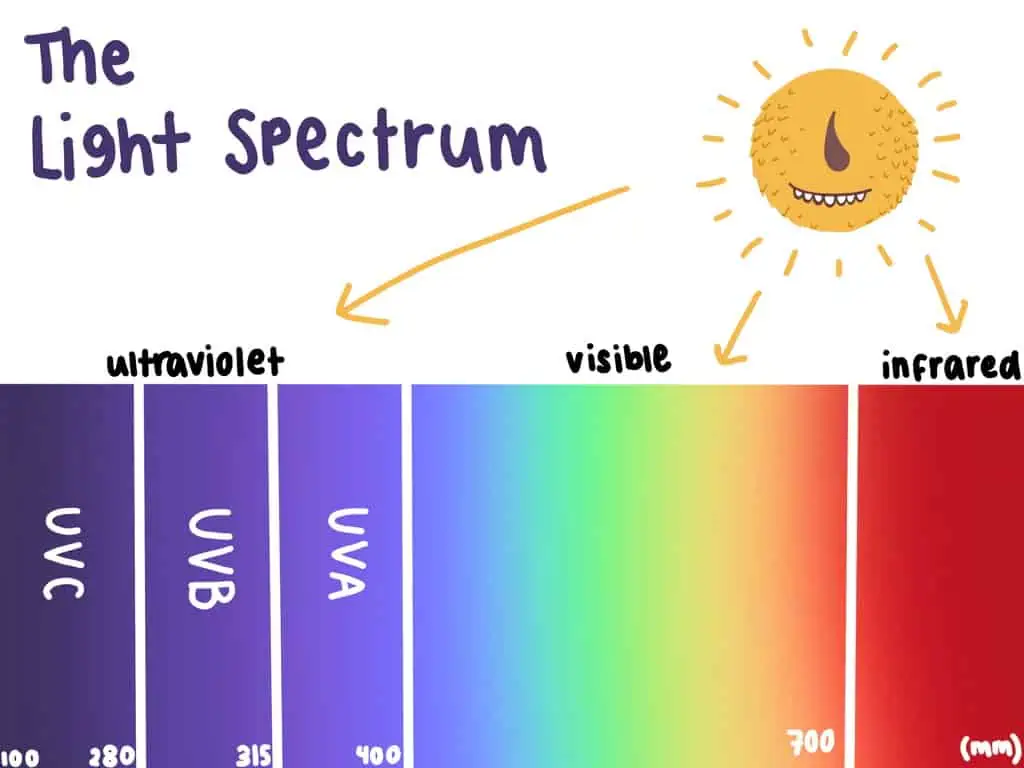Understanding the Differences: UVA, UVB, and UVC Explained
Table of Contents
Ultraviolet, or UV rays, are detrimental rays from the sun, constituting one type of electromagnetic radiation with wavelengths between 10 nm and 400 nm. UV rays with longer wavelengths are typically called ionizing radiations.

The earth’s ozone layer serves a crucial function by reflecting the sun’s rays, significantly reducing UV rays’ penetration. Considering wavelengths and photon energy, UV rays are categorized into three types: UVA, UVB, and UVC.
This article provides a comprehensive overview of UVA, UVB, and UVC, highlighting their distinct characteristics.
UVA Explained
UVA, a primary type of ultraviolet ray, possesses a longer wavelength and a wide electromagnetic spectrum within ultraviolet radiation (UVR). Notably, UVA is implicated in skin aging and the development of skin cancer.
UVA rays can penetrate deep into the skin, leading to premature aging and contributing to the onset of wrinkles, a process known as photoaging.
According to some experts, with a wavelength range of 315 – 400 nm and photon energy between 3.10 – 3.94 eV and 0.497 – 0.631 eV, the quality of UVA rays are approximately 500 times than UVB rays. Thus, UVA rays function as a protective barrier for the skin, mitigating the penetration of UVB rays. Due to their longer wavelength, UVA rays penetrate easily and are not absorbed by the ozone layer. Black lights or UVA rays contain a violet filter, resulting in a faint violet glow.
UVB Explained
UVB represents another form of invisible radiation originating from the sun. These rays significantly darken the skin and thicken its outer layer, primarily due to excessive melanin production stimulated by UVB radiation.
Furthermore, UVB rays are implicated in skin cancer by weakening the immune system’s ability to ward off such conditions. Eye irritation from UVB exposure is common. High-spectrum sunscreen is the best defense against UVB damage to the skin’s outer layer.
UVB’s wavelength is 280 – 315 nm, with photon energy values between 3.94 – 4.43 eV and 0.631 – 0.710 eV. Unlike UVA, UVB does not possess a long wavelength and can be absorbed by the ozone layer. In medicine, UVB radiation treats skin conditions such as vitiligo and psoriasis, often using special lasers or lamps emitting UVB rays.
UVC Explained
The earth’s ozone layer shields our planet by limiting the penetration of the sun’s ultraviolet rays. This layer effectively blocks UVC rays from reaching the earth’s surface.
Interestingly, UVC has germicidal properties and is utilized in ultraviolet phototherapy. It is primarily used to prevent airborne diseases caused by viruses and bacteria, limiting the spread of harmful germs.
UVC’s wavelength is 100 – 280 nm, with photon energy ranging from 4.43 – 12.4 eV to 0.710 – 1.987 eV. In medical applications, UVC is used in wound healing procedures using specialized lasers and lamps. Treating skin conditions such as vitiligo and psoriasis with UVC is a common practice among skin specialists.

Distinguishing UVA, UVB, & UVC: An Overview
The table below comprehensively compares these light rays based on various factors.
| Features | UVA | UVB | UVC |
| Wavelength (nm) | 315 – 400 | 280 – 315 | 100 – 280 |
| Length of wavelength | Long-wavelength UV | Medium-wavelength UV | Short-wavelength UV |
| Photon energy (eV, aJ) | 3.10 – 3.94,0.497 – 0.631 | 3.94 – 4.43,0.631 – 0.710 | 4.43 – 12.4,0.710 – 1.987 |
| Absorption by the ozone layer | The ozone layer of the earth doesn’t absorb it. | The ozone layer predominantly absorbs it. | The ozone layer completely absorbs it. |
| Penetration | Internal layers of the skin | Medium level | Topmost surface |
| Consequences | Construction of skin cancer. | Sunburn and malignant melanoma. | Intense burns of the skin and eye injuries (photokeratitis). |
Wavelength
The wavelength of a wave is defined by the distance between points that share the same phase. The wave’s medium significantly influences its wavelength. In the context of ultraviolet (UV) rays, the wavelength indicates the distance these waves can travel, and it outlines the shift of the rays between different mediums. UVA, UVB, and UVC wavelengths are 315 – 400 nm, 280 – 315 nm, and 100 – 280 nm, respectively.
Photon Energy
Photon energy refers to the energy possessed by a single photon. It’s crucial to understand that a photon’s wavelength is inversely related to its energy—meaning as the wavelength increases, the photon’s energy decreases. Simultaneously, the photon’s electromagnetic frequency heightens with the increase in photon energy. This kind of energy manifests the frequency of each photon relative to light beams, illustrating the intensity of UV radiation.
An interception by the Ozone Layer
The ozone layer in the earth’s stratosphere can absorb wavelengths ranging from approximately 200 to 310 nm, peaking at 250 nm. Given that the UVA wavelength spans 315 – 400 nm, it escapes absorption by the ozone layer. In comparison, UVB and UVC, with smaller wavelengths, are partially and fully absorbed, respectively.
Penetrative Power
The wavelength and intensity of UV radiation dictate the penetration capability of the rays. As the UVA wavelength is greater, it can infiltrate the skin more readily. UVB can reach up to the middle layers of the skin, while UVC interacts mainly with the surface layers.
Effects on Health
Different types of UV radiation result in distinct skin conditions. UVA is often associated with skin cancer, as it can be a key factor initiating its development. Excessive exposure to UVB results in sunburn and increased melanin production, potentially leading to malignant melanoma. Intense UVC exposure can induce photokeratitis, characterized by red eyes, swollen eyelids, headaches, and blurred vision.
What Kind of UV Ray is the Most Damaging?
Short-wavelength ultraviolet (UV) rays pose greater risks, with UVC being the most highly destructive type of UV radiation. Due to its limited penetration power, UVC is unable to pass through the ozone layer and reach the Earth’s surface.
Although UVC cannot directly cause skin cancer, it remains harmful when emitted from artificial light sources such as mercury vapor lamps. Prolonged exposure to UVC can result in serious skin problems and ulceration.
Which UV Ray is Responsible for Sunburn?
UVB radiation is the main cause of sunburn. Overexposure can damage the outer protective layer of the skin, making it a precursor to skin cancer. Prolonged sun exposure can harm squamous and basal cells, leading to skin cancer. Severe sunburns may result in irreversible skin conditions.
What Kind of UV Ray Leads to Melanoma?
Melanoma is a skin cancer type triggered by excessive melanin production, often induced by UVB exposure. Overexposure to the sun leads to oxidative stress and DNA damage, causing mutations. Skin inflammation is a common sign of melanoma.
How to Shield Yourself?
Protect yourself from the sun by wearing a wide-brimmed hat and sunglasses. Use high SPF sunscreen when outdoors but avoid excessive use. Seek shade between 10:00 am and 4:00 pm to enhance protection. Thick clothing, including synthetic and heavy fabrics, can also shield you from UV rays.
Summer days should be savored under a gentle sun rather than worrying about the damaging impacts of the sun and UV rays. Equipped with sunscreen, protective attire, and the right pair of sunglasses, you can confidently relish outdoor activities today without fearing skin damage tomorrow.
The Role of UVC in Hindering SARS-CoV-2 Reproduction
Does UVC hold potential in mitigating SARS-CoV-2? Interestingly, the answer is affirmative. It proficiently curbs the transmission of SARS-CoV-2. The virus’s potency is relatively low within biosafety level 3 (BSL3) laboratories.
Nevertheless, the virus’s impact can be proficiently assessed through dosage and concentration metrics. A 3.7 mJ/cm2 UVC dosage proves sufficient if a virus’s concentration is high.
This particular dosage is adequate to disable the cell cycle, thereby obstructing viral replication. A maximum dosage of 16.9 mJ/cm2 is necessary to halt the replication process completely.
UVC emerges as a crucial weapon that restricts the spread of the virus across a broad spectrum. Furthermore, UV radiation’s wavelengths dominate in eradicating harmful pathogens.
The expansive wavelength of UVC, 222 nm, proves to be an excellent catalyst as a disinfectant. Notably, this specific wavelength is safe for humans and doesn’t adversely affect health. Thus, exposure to UVC from KrCl excimer across wide areas helps minimize surface transmission of the virus.
KrCl* excimers damage nucleic acid and protein, showing higher protein absorbance at wavelengths around 222 nm from UVC.
Conclusion
Commonly, UV rays are viewed as detrimental. However, they have also proved beneficial in purification systems and medical applications. The negative impacts of UV radiation often overshadow its positive aspects. Once we delve into the subtypes of these beams, their intensity and effectiveness become readily discernable.
Unexpectedly, UVC also holds significant potential in curbing the replication or spread of the SARS-CoV-2 virus. People typically believe that UV radiations are invariably harmful to human health. However, specific UV ray wavelengths have consistently been utilized efficiently to protect humans from the lethal virus threatening their existence.
FAQs
UVA rays penetrate deeply into the skin, contributing to skin aging, wrinkles, and long-term damage like skin cancer over time. These rays are present year-round, even on cloudy days.
UVB rays are responsible for sunburns and play a key role in the development of skin cancer. They have more energy than UVA rays and primarily affect the outer layer of the skin.
UVC rays are the most dangerous but are completely absorbed by the Earth’s atmosphere, so they do not reach the surface. However, UVC rays from artificial sources, like certain lamps, can be harmful if not properly shielded.
Yes, UVB rays are a significant cause of skin cancer due to their ability to damage the DNA in skin cells, which can lead to mutations and the development of melanoma or other skin cancers.
To protect yourself from UVA and UVB rays, use broad-spectrum sunscreen with a high SPF, wear protective clothing, and avoid prolonged sun exposure, especially between 10 a.m. and 4 p.m. when UV rays are strongest.

Hi, I’m Xylia Xiong, a sales professional with 14 years of experience in the LED strip light industry. I specialize in providing tailored solutions, leveraging my expertise in LED products and the latest industry trends. Known for effective communication and problem-solving, I’m dedicated to helping lighting manufacturers, importers, and distributors achieve their goals.
Let’s work together to create customized solutions that exceed expectations.
Related Posts

The Best LED Strip Lights You Can Buy Right Now

Comparing WS2811 Vs WS2812B: Key Differences


